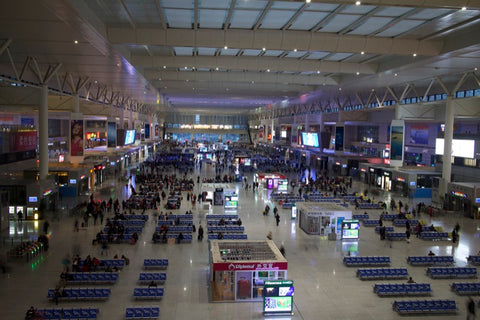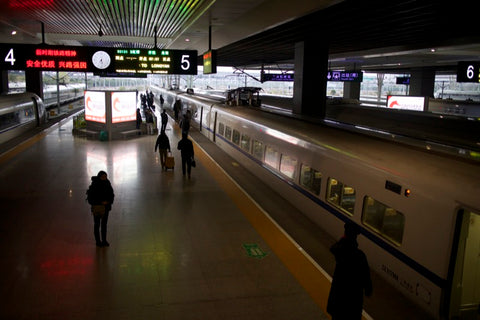Fuzhou
January 7, 2015
According to the Traditional Chinese Medicine (TCM) there are two main types of person, namely cold and warm individuals. Cold-body persons are easily affected by infections and tend to move and react slowly. They are sensitive to low temperature and often have cold feet. Warm-body persons are rather susceptible to inflammations. They are less calm, become easily irritated and are less sensitive to low temperature. I thought I was a warm-body person…
Wednesday evening, in a run-down villa on the hills north of Fuzhou city. No heating. I am writing the blog in a cold computer room fighting against slow Internet connection and frozen feet. I have all my cloths on and keep on drinking hot water to warm up. Right, no tea; just hot water. Home heating systems are not installed southern than the Yellow river. Houses are cold in winter and it’s normal to keep on the jacket also indoor. The Chinese guys sitting next to me seams to be insensible to low temperature. One is even wearing flip-flop without socks!

We arrived in Fuzhou in the afternoon on a high-speed train from Shanghai. Chinese high-speed railway stations are the most modern I have seen during my travels. They resemble airports, rather than train stations. Passengers wait in a huge hall and are allowed to the platform only few minutes before departure.


Upon arrival in Fuzhou we take a taxi to the Tea Department of the Fujian Agriculture and Forestry University. Y.W. warmly welcomes us it her tearoom. She knows that we are heading to Anxi and selected already different Tieguanyin teas for tasting (the most renewed of the teas produced in Anxi). We spend a pleasant afternoon together, drinking tea and collecting information for the next days. Worth mentioning are a 10 yeas old, compressed Shou Mei (white tea): thick and mellow (pictures below); and a heavily roasted Tieguanyin, darker than any TGY drunk so far. It tastes like a strong Wuyi Rock tea, without any sign of the floral notes and sweet aftertaste typical of Tieguanyin. I wonder if the first Tieguanyin produced centuries ago in Anxi was of this kind.
Y.W. explains us how to recognize the leaves of the Tieguanyin cultivar from the other tea plant varieties cultivated in Anxi: it is common practice to combine different cultivars together and pretend the blend being a pure Tieguanyin tea.
She also shows us two Chinese stamps used to sign tea packages; the meanings are:
“Make your heart warm with tea”
“For people who likes tea”




January 8, 2015
The night at the villa is not very restful. It’s cold and the roosters start singing at 4AM. Due to jetlag, Michela did not sleep properly also in the last days, so we decide to take a day off and remain in Fuzhou instead of proceeding to Anxi.
We visit our supplier of Tanyang Gongfu, a traditional black tea from Fujian province. The family owns tea fields and a small tea factory in the countryside, but also manage a teashop here in Fuzhou.
Winter is not a harvest season in Anxi and the best Tieguanyin from the autumn crop are certainly already sold out. Nevertheless we look forward to travel to Anxi. During the low season farmers and tea businessmen will have more time for us and we could also find new contacts, worth a visit in one of our next trip to China.
In the evening we take a bus to Anxi. W.W. is waiting for us with two friends. He grew up in a small village in the heart of Anxi and produced Tieguanyin with his family since the age of seven. In the meanwhile he lives with her wife and son in Guangdong province, where he works in the company of his stepfather, producing electronics components.
You can read excitement in his eyes; eager to show us around, practice English and extremely kind and considerate (even too much). He knows people in nearly every Anxi village and prepared for us a detailed tea tour.
Upon arrival we go straight to the restaurant. More friends come over and join us for dinner, curious to see the foreign friends of W.W.
Chinese are very hospital and helpful with foreigners. They always try to satisfy our need and fulfill our wishes. We shall weigh our words to avoid them doing somersaults to help us in even futile needs. W.W. is no exception. In the next two days we will never pay for meals, accommodation and transportation.
After dinner we go to a friend’s teashop for a round of Tieguanyin, the first of many: 7 grams of leaves for a small gaiwan, 100°C water and 10-30 seconds steeping time. The leaves are carefully weighted while not much attention is paid to the steeping time. Just one or two brews for each tea before moving to the next (what a waste!). We taste five teas from different villages:
- Hushang: floral, pleasant
- Xiping: fuller with a light milky texture
- Gande: not convincing
- Jiandou (middle fire): sweet and intense smell, unfortunately covered in the taste by the too strong roasted flavor.
- Xianghua: floral but with unpleasant wet grass off-taste. Was this tea not dried properly?
Except for the first two teas the tasting was quite disappointing. I take samples of Hushan and Xiping to compare with my TGYs once back in Europe.
Below a low-fire and a middle-fire Tieguanyin. More about roasting level in the next blog entry.


Time to go to bed. Tomorrow we will get up early and, after a meeting with a famous tea master, we will drive to Xiping, in the countryside.
Written by Gabriele.





